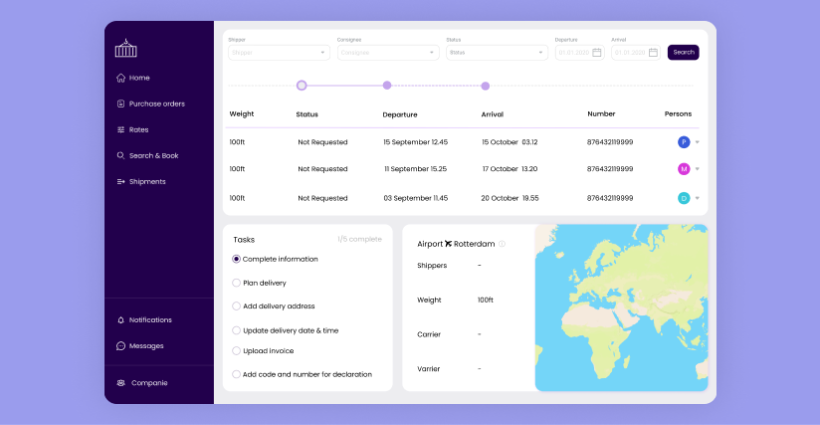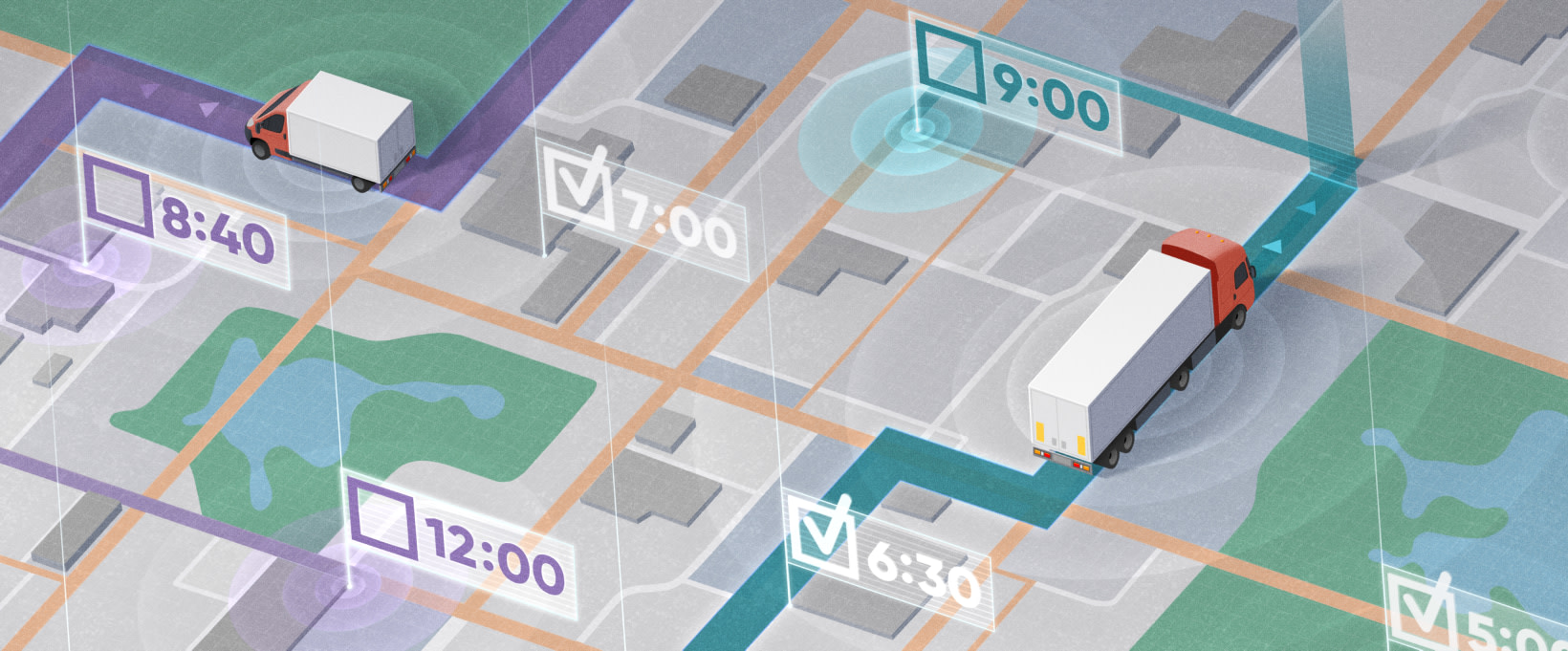- What is logistic tracking software?
- Business benefits of logistic tracking software
- Custom vs off-the-shelf logistic tracking software
- The advantages of custom solutions
- Pros of implementing off-the-shelf software
- Step by step logistic tracking software development
- Select a provider
- Start a project Discovery phase
- Initiate product development
- Follow the QA process
- Adopt the solution
- Scale up
- Logistic tracking software use cases
- IoT and Big Data-based logistic solution for cargo owners and other supply chain participants
- Web-based application to manage supply chains and freight
- Conclusion
Logistics has undergone significant changes after the pandemic, border closures, and transportation restrictions. The changing times dictate new rules and solutions. To overcome the challenges and establish adaptable and effective flows, the industry should consider implementing modern logistic tracking software. In this blog post, we will analyze the approaches to creating such software and its benefits for organizations.
What is logistic tracking software?
Transportation companies resort to logistic tracking software development to automate complex tasks and optimize an operating cycle. Such digital solutions are used for delivery planning, task allocation, optimization of routes, tracking resources, and more. Tracking software ultimately reduces transport expenses and improves the efficiency of customer service.
Software for logistics can be introduced in separate domains, such as order management, warehousing, or inventory management. Such software can be tailored for both small logistics companies and the giants of transportation services. It can connect manufacturers and customers and build a flexible supply chain even in rough times that are full of limitations and restrictions on transport operations.
By 2030, the logistic software market is projected to exceed $17.7 billion, growing at a compound annual growth rate of about 8%. Such growth is illustrative of the increasing popularity of transportation management software contributing to substantial improvement in logistic companies’ operations.
Business benefits of logistic tracking software
Implementation of logistic software leads to the optimization of the whole business cycle in these ways:
- Minimized human error. Automation eliminates the possibility of inputting the wrong information or parameters. It optimizes inventory planning and can control shipping situations in real-time under all possible circumstances.
- Workflow automation. With digital tools, a logistic company streamlines document management, processes inquiries, and tracks payments to eliminate time-consuming manual tasks.
- Transparent supply chain. Tracking software allows tracing internal and external operations so that a company won’t miss any of its goals and will get an opportunity to build clear relations with the other participants in the chain.
- Resource optimization. By embracing a solution for vehicle tracking, a company will help its managers to analyze the workload of the drivers and the causes of potential delays.
- Reduced costs. By optimizing the use of resources and routes, excluding human errors, and simplifying paperwork, companies will reduce their expenses.
Custom vs off-the-shelf logistic tracking software
When it comes to choosing suitable software, companies consider either implementing a ready-made solution or developing a tailored one from scratch. Each approach has its advantages and limitations so let’s consider them.
Custom logistics software development involves creating solutions according to the specific needs of a customer. For example, a company may have a specific set of parameters for the search for suppliers or monitoring the activities of their drivers.
The advantages of custom solutions
- Focus on specific needs — custom software is created according to your purposes and matches your business processes in the best way;
- Scalability — a company has access to the source code of their solution so that the software can be upgraded if you have changing demands;
- Cost-effectiveness — when you invest in a custom solution, you pay only for the features you need, which is more flexible than buying a subscription for ready-made software.
Custom software development may have its limitations as well:
- Time for development — the creation of custom solutions takes more time than purchasing ready-made software, though it is justified by the results when all the needed technical requirements are followed;
- Higher costs — boutique solutions are created according to individual demands, which can not cost less than ready-made software.
Pros of implementing off-the-shelf software
- Relatively low prices — ready-made solutions usually have various subscription plans according to the size of a business and the scope of its tasks. Sometimes providers offer free trials;
- Short-term implementation — it doesn’t take much time to start using off-the-shelf logistics software after purchasing.
At the same time, the users of such solutions highlight the following cons:
- Limited functionality — off-the-shelf solutions usually provide a standard set of functions, which may be not enough for meeting particular business needs;
- Security vulnerability — providers can not always guarantee the highest security level as their products are designed for average user needs;
- Limited technical support — software vendors may have limited technical support services for customers and it may take time to fix your issue;
- Delayed scaling — it may be complicated to add new features promptly to off-the-shelf solutions. You have to wait for updates.
Step by step logistic tracking software development
When a company is considering building logistic software from scratch, it should be aware of the key stages of the process.
Select a provider
Finding the right provider of software services is the cornerstone of the successful implementation of your requirements. Pay attention to the experience and specialization of your potential technical partner. They should be familiar with the logistic field.
Start a project Discovery phase
Take the time to discuss your needs and expectations with the selected development team. They will help you decide on the functionality, estimate the time and costs for the solution you need, as well as clarify the project’s scope and tasks.
Initiate product development
Software engineers can build a cloud or on-premises solution for your business. You may also need a mobile version of your software. Stay in touch with your development team during this phase and don’t neglect regular online meetings to stay on the same page and track progress.
Follow the QA process
When the developers’ work is done, quality assurance specialists review the solution developed, its functionality and performance. As a product owner, you may take part in the second stage of software testing and check the solution’s robustness yourself.
Adopt the solution
When your software is ready and works correctly, it’s time to train your employees to work with it. Your team can also provide valuable feedback about the product that was created. If everything was deployed properly, you will soon experience the benefits of the new software.
Scale up
Businesses don’t stay still, so it’s important to adjust your software to changing conditions. When you decide that it’s time to scale up or modify your operations, you can turn to the developers again and ask them to modify your solution or integrate it with other products that have become necessary.
Logistic tracking software use cases
At Andersen, we have worked with logistic companies all around the world to design, implement, and test software. Below are some of our projects.
IoT and Big Data-based logistic solution for cargo owners and other supply chain participants
The customer needed software for managing assets and goods on a global scale with more than 450 parties involved in the processes. Our engineers created an intelligent cloud platform, as well as web-based software for the management of rail and tank container fleets.

The customer got the following benefits:
- An analytics engine to optimize cargo handling, which helped to prevent 30,000 tons of carbon dioxide emissions in 2021;
- An event processing engine to apply triggers to cover specific use cases;
- Big data processing for monitoring flows;
- User and access management features for streamlining administrators’ work.
Web-based application to manage supply chains and freight
Our customer wanted to enable their users to search, filter, and book freight forwarding services. We created a web application that provided such options, as well as real-time rates, schedules, and conditions of different carriers.

With the help of the developed solution, the customer achieved the following results:
- 98% decrease in invoice errors and effective data flows between the parties involved in the supply chains;
- 30% increase in operational efficiency;
- 10% improvement in inventory optimization.
Conclusion
A custom logistic solution is an excellent tool for enhancing and streamlining stock management, order management, or transportation. With effective software, a logistic company can adapt to the market even under changing conditions. If you are interested in optimizing your business processes, feel free to contact us.










